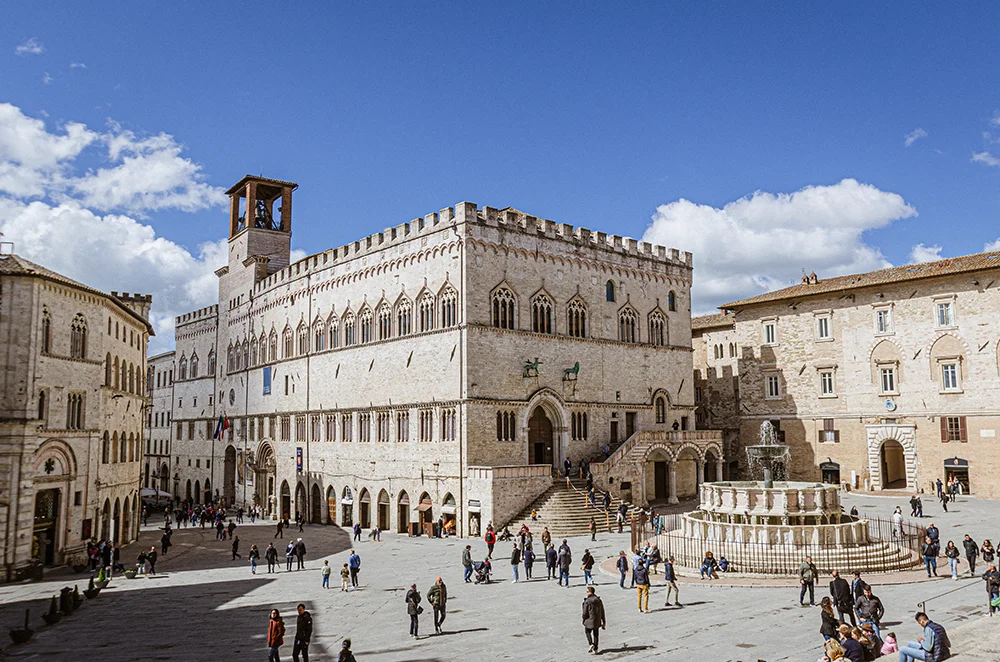As the capital city of Umbria, Perugia is a must visit when you travel the region. Perugia sits on a hilltop from which you could admire the beautiful landscapes of Umbria. Originally founded by the ancient Etruscans and then embodied in the Roman Empire, Perugia’s architecture is an enchanting mixture of the last two millennia. With its arches, churches, hidden streets and medieval passages, there is no way you could leave the city without being fascinated by it in some way.
During the year Perugia hosts many renowned cultural events such as the Umbria Jazz Festival and Eurochocolate, among many others like the International Journalism Festival and the medieval Perugia 1416. During these events the city center could be very crowded but definitively worth a visit. I’ve put together a list of things and places you should consider to visit to have a full Perugia experience.
1. Piazza IV Novembre and Fontana Maggiore
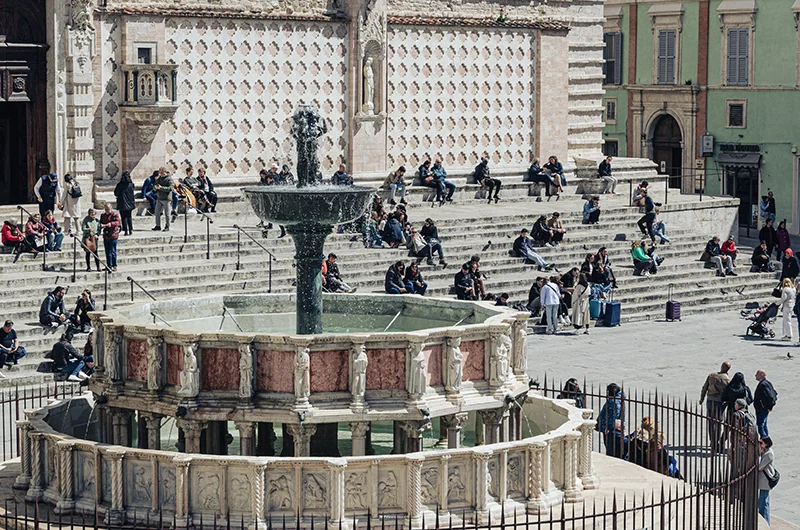
The Fontana Maggiore (Major Fountain) is really the center of the city and one of the most iconic places of Perugia. It sits in Piazza IV Novembre (4th November Square), the most famous square of the city. Surrounded by medieval palaces and most of the other interesting things of the city center, Fontana Maggiore was built in the Middle Age (between 1278 and 1280 A.D.) by Nicola and Giovanni Pisano to celebrate the completion of the medieval aqueduct (more on this below). It is made of two circular tubs, one over the other, and is adorned with 50 bas-reliefs and 24 statues. Without any doubt it is one of the best example of the Italian medieval sculpture.
2. Palazzo dei Priori
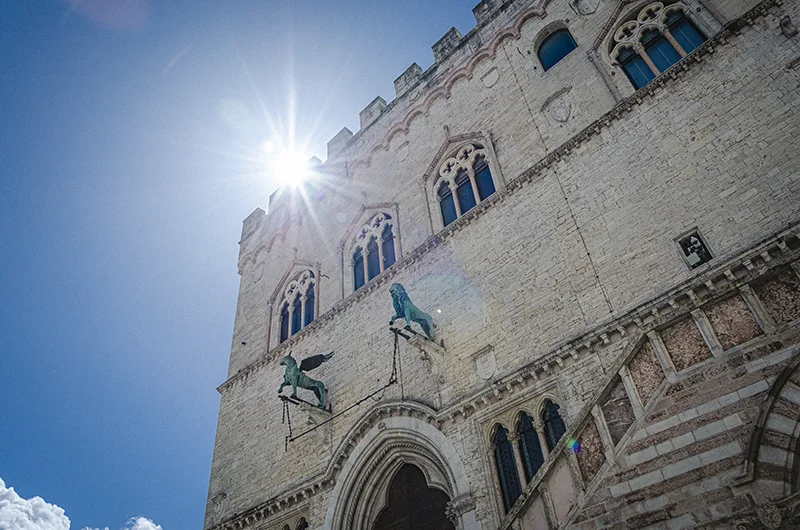
Right next to Fontana Maggiore you can see the magnificent Palazzo dei Priori (Priori’s Palace), also built during the Middle Age. During the era of the communes the Priors were 10 representatives of the various guilds of the city which established laws and administered the city. Palazzo dei Priori is quite a big palace and today is divided in different areas you could visit from various entrances.
Sala dei Notari (Notaries Hall) is a beautiful piece of medieval art with all its walls covered with frescos. Entering the hall you will travel back in time. Above the massive door you will see the bronze statues of the Griffin, representing the people, and the Lion, representing the Comune. You can find the originals inside the entrance of Galleria Nazionale dell’Umbria. From the chain that connect them hang the keys of Siena, stolen from the city’s gates after the battle of 1358 A.D. The entry is free.
With over 3,000 pieces, distributed on 3,500 square meters and 40 exhibition rooms, Galleria Nazionale dell’Umbria (Umbria National Gallery) is a museum for those who wish to dig deeper in the Italian art from the Gothic style to the Renaissance. It features artist like Duccio di Buoninsegna, Beato Angelico, Benozzo Gozzoli and Piero della Francesca (with his masterpiece “polyptych of St. Anthony” in Room 13). During the year it also hosts temporary exhibitions. The ticket is currently 10€. Please check opening hours on the official website.
Nobile Collegio del Cambio (the Noble Guild of Moneychangers) and Nobile Collegio della Mercanzia (the Noble Guild of Merchants) are two smaller sections of Palazzo dei Priori, but nonetheless fascinating. You can find their entrances at the right and left of Galleria Nazionale dell’Umbria’s portal. The Guild of Moneychangers contains some frescos from Perugino, Raffaello’s master, two depicted halls and a collection of historical coins from 15th to 19th century. The Noble Guild of Merchants is a unique wooden coated hall from the 15th century with golden decorations. You can visit them individually with a single ticket or buy a combo one for 7€.
Another option is the guided tour called Civitas Perusina which takes place every Saturday at 10 AM and includes both the Nobile Collegio del Cambio, the Nobile Collegio della Mercanzia and the first floor of Palazzo dei Priori. The tour should be booked, more details on their websites above.
3. S. Lorenzo Cathedral

The construction of the Cathedral of S. Lorenzo started in March of 1300 A.D. to replace an older romanic church, built in turn over the Roman and Etruscan acropolis, which today is under the ground, making this a worship place since the 6th century B.C. The original project of the cathedral was developed by friar Bevignate, also involved in the construction of Fontana Maggiore and the Orvieto Cathedral. Due to many reasons the cathedral has never been finished and you can only image how it could’ve been by looking at the south entrance facing Palazzo dei Priori. Five conclaves, the election of the Pope, took place here.
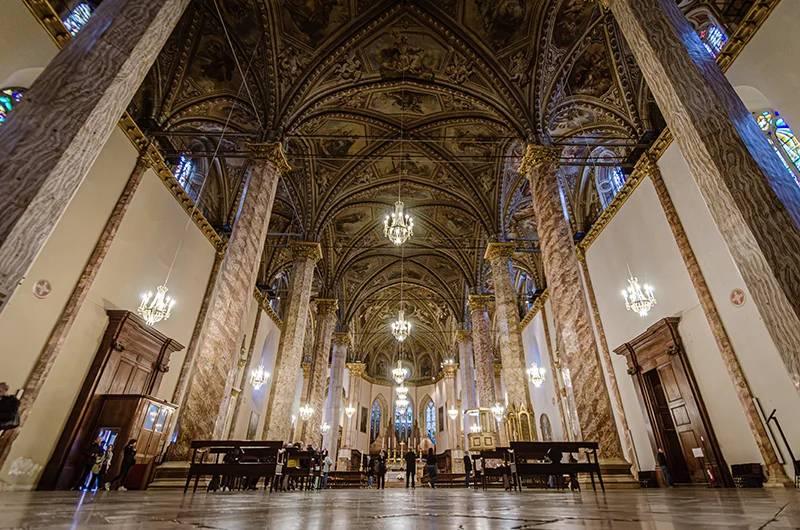
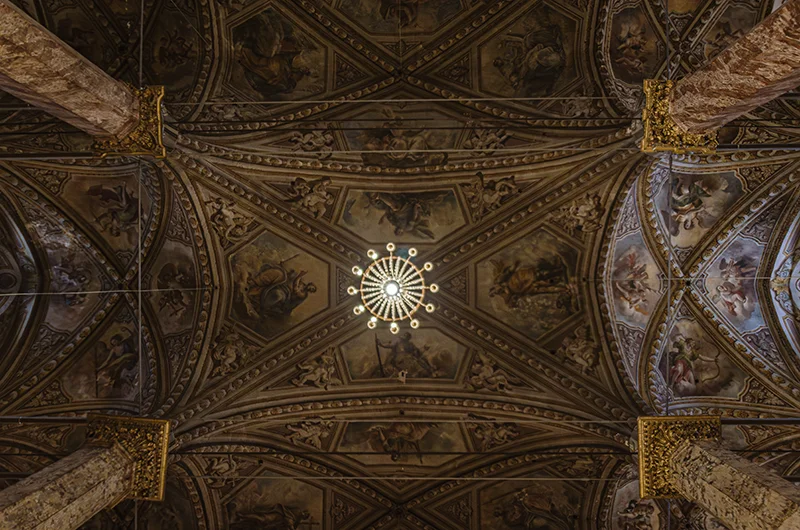
At the left of S. Lorenzo Cathedral you will also find the entrance of the chiostro. Here you have the chance to visit the cathedral’s museum and Perugia Underground, a unique 45 minutes guided tour which will take you through the 2,600 years of Perugia’s history.
The ticket for the underground is 10€ and during high season it would be better to book the tour in advance. If you also want to include a visit to the museum the pass is 15€. Buying these tickets will give you a discount on the Etruscan Well one, so you could consider visiting this one first. More info on Isola San Lorenzo website.
4. The Etruscan Well
As the name suggests the Etruscan Well was built by the ancient Etruscans and is a masterpiece of hydraulic engineering. The well is 36 meters deep and dates back to around the 3rd century B.C., it has been vital for the water supply of the city since then. Visiting the well does not take too much time and you can couple it with a visit of Sorbello Palace just above. It is open every day from 10 AM to 2 PM and from 3 PM to 5:30 PM.
The regular ticket is 4€ or 2.5€ if you already visited Perugia Underground tour, 9€ if you want to visit Sorbello Palace too.
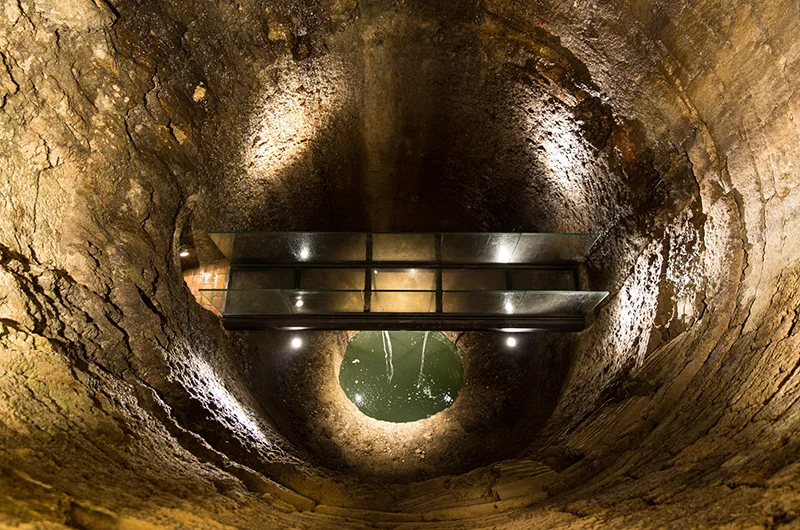
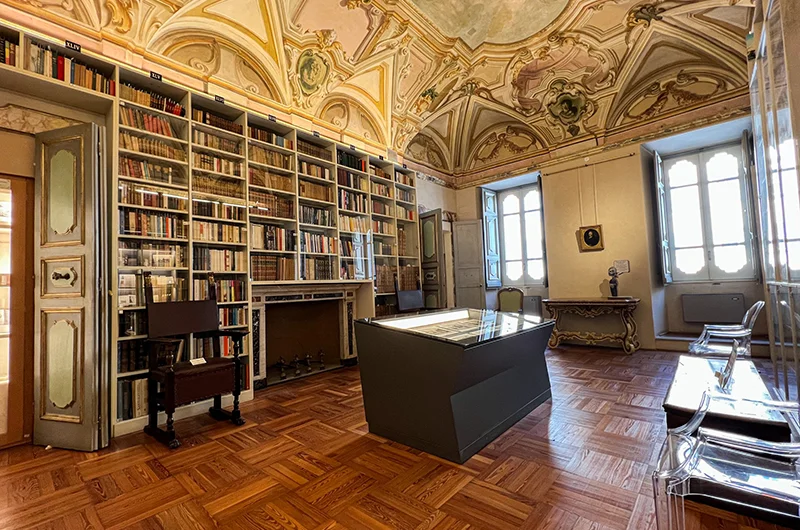
5. Corso Vannucci
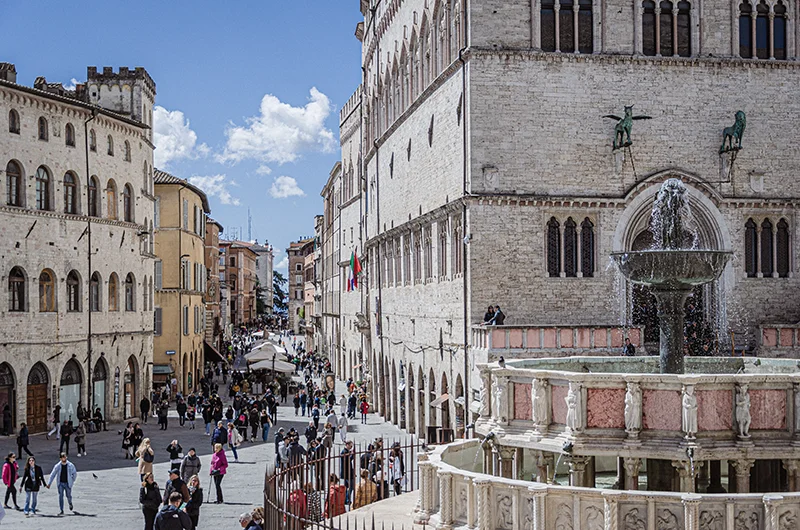
There is no chance you will visit Perugia city center without walking through Corso Vannucci. This is the main street of the acropolis and the most famous one, named after the renaissance painter Pietro Vannucci called Perugino.
Along Corso Vannucci you can find many shops, bars and restaurants to have lunch or dinner. Here you can also taste the typical torta al testo or porchetta sandwiches. Also look for truffle and chocolate shops. The best thing you can do in Perugia center is to get lost inside the small streets that branch out from Corso Vannucci.
Walking from Fontana Maggiore through Corso Vannucci you will get to Rocca Paolina and Carducci Gardens.
6. Rocca Paolina and Carducci Gardens
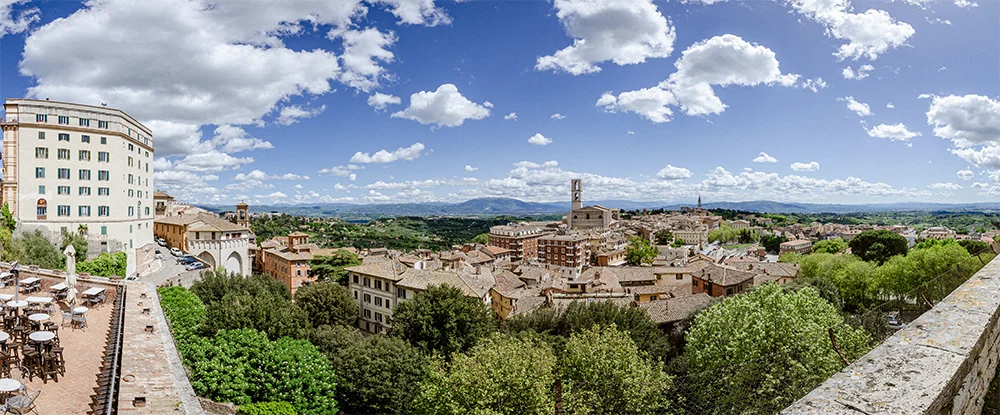
Arriving from Corso Vannucci to Carducci Gardens you will be blown by a beautiful view of the countryside of Umbria and you can relax on a bench, maybe with a tasty ice cream. Just cross the road and you will get the most panoramic spot of Perugia. From the belvedere the view is sublime. Besides the bell towers of S. Domenico and S. Peter, you can contemplate Assisi and Mount Subasio, the Sibillini Mountains or, on a clear day, you can spot many of the main cities of Umbria that are far away.
The thing to notice here is that while walking in the Carducci Gardens you are actually above Rocca Paolina and its rooms. Rocca Paolina is an ancient fortress wanted by Pope Paul III in the middle of the 16th century, after the Salt War, and named after him. The fortress was built by occupying the existing houses of the people who lived there, therefore many of its rooms are actually the ancient houses expropriated from the owners. Today Rocca Paolina is open to anyone and host many exhibitions. To go inside just take the escalators in Piazza Italia.
7. Medieval Aqueduct

Probably the Medieval Aqueduct is one of the most famous spots of Perugia thanks to its scenographic set. Did you ask yourself how was it possible in the Middle Age to fuel with water Fontana Maggiore as it sits on the top of the hill? Well, it was possible because of the aqueduct.
Its construction started in 1254 A.D. and it was another masterpiece of hydraulic engineering: using only pressure it was able to bring water from the hill in front of the city center to the fountain. Basically it gave water an upwards direction without using any pump.
The aqueduct was dismissed in the middle of 19th century and transformed into a walkable street. Houses were born on the sides. Today the aqueduct is a nice walk with many steps, ancient arches and a unique feeling.
8. The Etruscan Arch
With its 11 meters of height the Etruscan Arch is a massive stone arch built by the Etruscans in the 3rd century B.C., before the Romans. At the time it was the main entrance of the city. After the war with Romans, which sieged Perugia for 7 months, the arch was renovated around 40 BC by emperor Augustus who, without any ego, had the inscription “Augusta Perusia” engraved at the top. You can still see it today.
9. Sciri Tower and S. Francesco al Prato Church
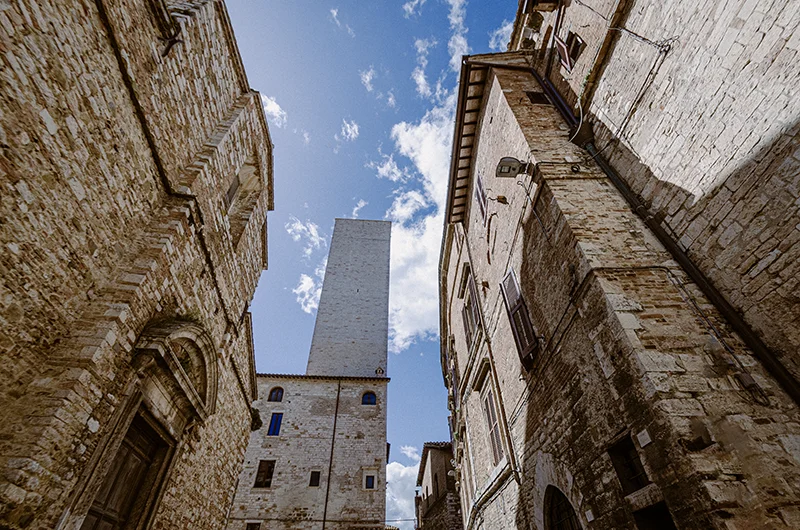
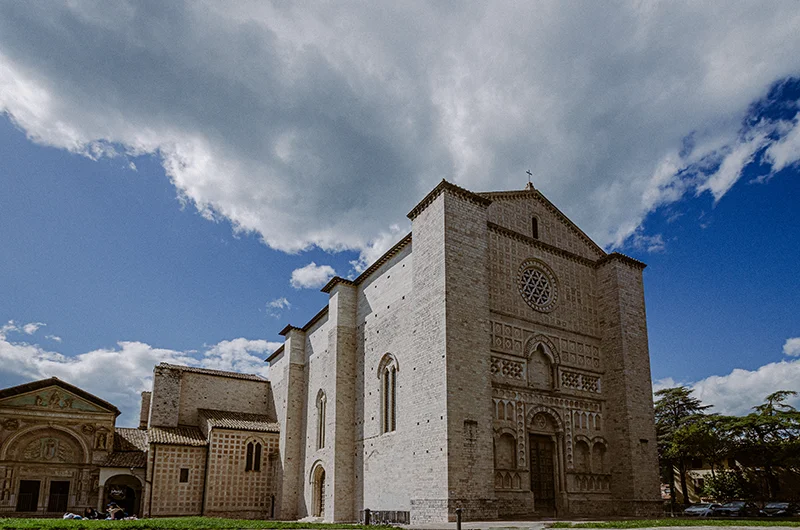
From Corso Vannucci take Via dei Priori by passing through the arch on the left of Galleria Nazionale dell’Umbria. After losing yourself in the small streets on the left and right of Via dei Priori you will arrive just below the Sciri Tower, named after the noble family who owned it in the late 15th century. The tower is the only survivor of the many towers that characterized Perugia during the Middle Age (someone says there were at least 40 towers).
After a recent restoration you can climb to the top terrace and enjoy an unusual view of Perugia from its 42 meters of height. The entrance is free but only open on specific events. You can find out more on Facebook or Instagram.
10. S. Peter Abbey
While not really inside the immediate center of Perugia, you can easily reach S. Peter Abbey with a 15 minutes walk. If you come from Corso Vannucci you can take the chance to walk through S. Ercolano stairs and its church, visit Palazzo della Penna museum with its permanent exhibition of Gerardo Dottori futuristic paintings and, by continuing on Corso Cavour, you can also visit the imposing church of Basilica di S. Domenico. After passing Porta San Pietro you will finally arrive at S. Peter Abbey with its unique bell tower.
Probably S. Peter Abbey is one of the most beautiful churches of Perugia, thanks to its unique architecture and its abundance of art. Visiting this abbey you will find 3 cloisters, a botanic garden, a crypt, an art gallery, an archive with ancient manuscripts but also many pieces of art from Perugino, Vasari or Raffaello.
But what will stumble upon your eyes while visiting the main naive will be a series of big paintings from Antonio Vassilacchi made at the beginning of the 17th century. Most notably is the one opposed to the apse, named “Triumph of the Benedictine order”, which depicts about 300 Benedictine characters including Popes, saints and son, but has an hidden secret: if you look at it from some distance you will notice a creepy face of the devil. Did you spot it?

11. (Bonus) Via della Viola
Just about a couple of minutes from the main square there is a funny and particularly interesting street named Via della Viola (like the instrument). Once a really degraded area, this street has come to a new life and is gaining popularity among students, because of many small drinking spots opened during week end’s nights. If you don’t want to join Saturday night’s movida you can just walk through it, and its adjacent small streets, by daytime and be surprised by many curious art installations and graffiti, some made by renowned local street artists, which make via della Viola one of the most creative streets of Perugia. To go back to Piazza IV Novembre please take the stairs passing under Arco del Giglio. It is beautiful.

